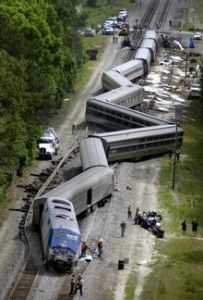Best chroniclers of bullet-train follies miss obvious angle on self-driving cars
by CalWatchdog Staff | September 26, 2012 6:15 am
 [1]
[1]
Sept. 26, 2012
By Chris Reed
Mike Rosenberg of the San Jose Mercury-News — the newspaper reporter and the California newspaper who/that have done by far the best job of straight-forwardly[2] illustrating the lunacy[3] of the high-speed rail project — somehow missed a fresh chance to point out its stupidity.
Rosenberg’s coverage[4] Tuesday of Gov. Jerry Brown’s signing of the Google self-driving-car legislation inexplicably didn’t mention this angle:
Cooperative self-driving cars could nearly triple the capacity of our highways, says a new study on the potential benefits of autonomous vehicles. By working together, cars can travel far more efficiently than if they act on their own.
The paper[5] is being presented this week at an Institute of Electrical and Electronics Engineers (IEEE) conference on vehicular technology. Its author, Columbia University’s Patcharinee Tientrakool, wrote her dissertation on a method for cars to communicate safely and reliably that she calls “reliable neighborcast protocol,” or RNP.
Research in self-driving vehicles has naturally focused on how to make the car imitate an intelligent driver: recognizing and navigating obstacles, reading signs and performing other common tasks. If there were only going to be a single such vehicle on the road, surrounded by human-guided cars, then that’s the most important thing to perfect. But what if nearly every car on the road is a robo-car?
Tientrakool’s paper looks at the difference in efficiency between when autonomous vehicles don’t communicate and when they act as a team. She concludes that cars simply managing their own speed would increase efficiency by an appreciable 43 percent, but if they were working together, that number jumps to a staggering 273 percent.

Patcharinee Tientrakool / Columbia University
Cars would achieve this by banding together into groups, driving much closer to one another than humans do, and working out the best possible solution to things like merging and changes in traffic. Another study (PDF) [6]by Steven Shladover at UC Berkeley’s Institute of Transportation Studies makes similar predictions based on this “platooning” of vehicles.
Doesn’t this make a lot more sense than bullet trains? Wouldn’t it be vastly cheaper?
Of course.
Read the whole thing here[7].
As for Mike Rosenberg, as Keyshawn Johnson would say, “Come on, man!” How about a weekend follow on this angle?
Mike?
Mike?
Mike?
- [Image]: http://www.calwatchdog.com/2012/09/13/will-gov-brown-kill-self-driving-cars-as-threat-to-bullet-train/train_wreck_num_2/
- straight-forwardly: http://www.mercurynews.com/california-high-speed-rail/ci_21046596/californias-bullet-train-faces-new-challenges-after-funding
- lunacy: http://www.mercurynews.com/california-high-speed-rail/ci_21033651/joe-simitian-steady-hand-high-speed-rail-debate?source=rss
- coverage: http://www.mercurynews.com/cars/ci_21627191/google-driverless-robot-car-law-jerry-brown-signs-law-sergey-brin
- The paper: http://ieeexplore.ieee.org/xpl/articleDetails.jsp?reload=true&arnumber=6093130
- Another study (PDF) : https://docs.google.com/file/d/1QEEogRPad6GdijKzxhb9ApnMlNszTDGGZn2YTpzbdaOE5teZH2QB17bYiW3S/edit
- here: http://www.nbcnews.com/technology/futureoftech/robot-cars-could-increase-highway-efficiency-273-percent-study-978760
Source URL: https://calwatchdog.com/2012/09/26/best-chroniclers-of-bullet-train-follies-miss-obvious-angle-on-self-driving-cars/